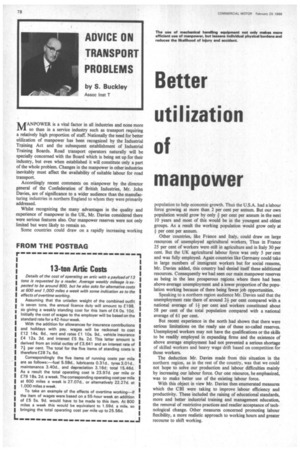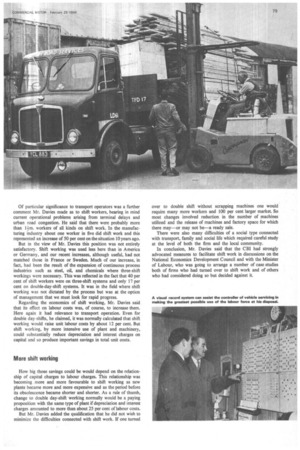Better utilization of manpower
Page 80

Page 81

If you've noticed an error in this article please click here to report it so we can fix it.
MANPOWER is a vital factor in all industries and none more so than in a service industry such as transport requiring a relatively high proportion of staff. Nationally the need for better utilization of manpower has been recognized by the Industrial Training Act and the subsequent establishment of Industrial Training Boards. Road transport operators naturally will be specially concerned with the Board which is being set up for their industry, but even when established it will constitute only a part of the whole problem. Changes in the manpower in other industries inevitably must affect the availability of suitable labour for road transport.
Accordingly recent comments on manpower by the director general of the Confederation of British Industries, Mr. John Davies, are of significance to a wider audience than the manufacturing industries in northern England to whom they were primarily addressed.
Whilst recognizing the many advantages in the quality and experience of manpower in the UK, Mr. Davies considered there were serious features also. Our manpower reserves were not only limited but were likely to remain so.
Some countries could draw on a rapidly increasing working population to help economic growth. Thus the U.S.A. had a labour force growing at more than 2 per cent per annum. But our own population would grow by only per cent per annum in the next 10 years and most of this would be in the youngest and oldest groups. As a result the working population would grow only at per cent per annum.
Other countries, like France and Italy, could draw on large resources of unemployed agricultural workers. Thus in France 25 per cent of workers were still in agriculture and in Italy 30 per cent. But the UK agricultural labour force was only 5 per cent and was fully employed. Again countries like Germany could take in large numbers of immigrant workers but for social reasons, Mr. Davies added, this country had denied itself these additional resources. Consequently we had seen our main manpower reserves as being in the less prosperous regions where there had been above-average unemployment and a lower proportion of the population working because of there being fewer job opportunities.
Speaking to a northern region audience Mr. Davies said that the unemployment rate there of around 2-1per cent compared with a national average of 1+ per cent and workers constituted about 58 per cent of the total population compared with a national average of 61 per cent.
But recent experience in the north had shown that there were serious limitations on the ready use of those so-called reserves. Unemployed workers may not have the qualifications or the skills to be readily employed in expanding firms and the existence of above average employment had not prevented a serious shortage of skilled workers and heavy wage drift based on competition for those workers.
The deduction Mr. Davies made from this situation in the northern region, as in the rest of the country, was that we could not hope to solve our production and labour difficulties mainly by increasing our labour force. Our one resource, he emphasized, was to make better use of the existing labour force.
With this object in view Mr. Davies then enumerated measures which the CBI were taking to improve labour efficiency and productivity. These included the raising of educational standards, more and better industrial training and management education, the removal of restrictive practices and readier acceptance of technological change. Other measures concerned promoting labour flexibility, a more realistic approach to working hours and greater recourse to shift working.
Of particular significance to transport operators was a further comment Mr. Davies made as to shift workers, bearing in mind current operational problems arising from terminal delays and urban road congestion. He said that there were probably more than workers of all kinds on shift work. In the manufacturing industry about one worker in five did shift work and this represented an increase of 50 per cent on the situation 10 years ago.
But in the view of Mr. Davies this position was not entirely satisfactory. Shift working was used less here than in America or Germany, and our recent increases, although useful, had not matched those in France or Sweden. Much of our increase, in fact, had been the result of the expansion of continuous process industries such as steel, oil, and chemicals where three-shift workings were necessary. This was reflected in the fact that 40 per cent of shift workers were on three-shift systems and only 17 per cent on double-day-shift systems. It was in the field where shift working was not dictated by the process but was at the option of management that we must look for rapid progress.
Regarding the economics of shift working, Mr. Davies said that its effect on labour costs was, of course, to increase them. Here again it had relevance to transport operation. Even for double day-shifts, he claimed, it was normally calculated that shift working would raise unit labour costs by about 12 per cent. But shift working, by more intensive use of plant and machinery, could substantially reduce depreciation and interest charges on capital and so produce important savings in total unit costs.
More shift working
How big those savings could be would depend on the relationship of capital charges to labour charges. This relationship was becoming more and more favourable to shift working as new plants became more and more expensive and as the period before its obsolescence became shorter and shorter. As a rule of thumb, change to double day-shift working normally would be a paying proposition with the same type of plant if depreciation and interest charges amounted to more than about 25 per cent of labour costs.
But Mr. Davies added the qualification that he did not wish to minimize the difficulties connected with shift work. If one turned over to double shift without scrapping machines one would require many more workers and 100 per cent larger market. So most changes involved reduction in the number of machines utilized and the release of machines and factory space for which there may—or may not be—a ready sale.
There were also many difficulties of a social type connected with transport, family and social life which required careful study at the level of both the firm and the local community.
In conclusion, Mr. Davies said that the CBI had strongly advocated measures to facilitate shift work in discussions on the National Economics Development Council and with the Minister of Labour, who was going to arrange a number of case studies both of firms who had turned over to shift work and of others who had considered doing so but decided against it




























































































































